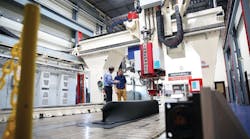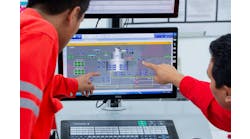The Industrial Internet of Things (IIoT) isn’t new. In fact, it’s spread so far so quickly that we’ve almost forgotten about the hurdles to implementation. And thank goodness for that. With the global pandemic and the need to social distance for so many workers, the ability to connect to plants and machinery and data via remote access has been fortuitous.
Where would manufacturing have been 10 or 15 years ago without the ability to connect with machinery remotely, save for the firewall-protected VPN.
But, now that devices, machinery and plants are connected, and the benefits have become obvious, what happens after the COVID crisis subsides in the face of mass vaccinations? Will IIoT run out of steam, as factories are able to return to normal operations?
“The pandemic has emphasized just how important building smart equipment and enhancing our remote service offering is,” says John Block, vice president of purchasing & customer service, Brown Machine Group, which provides thermoforming equipment from its facility in Beaverton, Michigan. “Although we were headed down the path to smart equipment prior to the pandemic, it accelerated our plans as customers need this technology; those who truly embrace and champion it will be more successful. Exploiting every opportunity for advantage is key in today’s uncertain environment, and we’ve got a product that can assist in multiple ways, starting the payback cycle immediately.”
Connection through collaboration
Ingersoll Machine Tools in Rockford, Illinois, and Siemens expanded their decade-long partnership to support the machine-tool company of Camozzi Group on its digital journey of creating digital twins of its products and expanding into new markets (Figure 1). Based upon extensive experience in heavy machine tool building, Siemens’ cutting-edge technologies in hardware complement Ingersoll Machine Tools’ successful journey into the new market of additive manufacturing and have pushed the boundaries for industrial robots for the aerospace market with its entry-level robotic platforms MasterPrint Robotic and MasterPrint Continuous Filament.
For example, Ingersoll developed the mammoth 3D printer MasterPrint, the world’s largest device that prints with thermoplastics. The MasterPrint at the University of Maine, which has been included in the Guinness Book of World Records, is able to 3D-print objects up to 100 ft long, 20 ft wide and 10 ft tall. It is designed mainly to make tools for the aerospace, space and marine industry.
MasterPrint cuts cost and streamlines the manufacturing process. Large parts are printed and then machined to final their shape with the same machine. Manufacturing costs can be reduced by 75% and lead times shortened from months to days.
“As a key supplier of high-tech manufacturing equipment to all the major players of the aerospace industry, Ingersoll has strategic technology goals that push CNC product capabilities and performance beyond their OEMs’ intentions, conception and scope in term of accuracy, reliability, ease of integration and seamless programming experience,” says Piergiorgio Assandri, business director at Ingersoll Machine Tools (Figure 2). “Ingersoll has found a CNC and software partner in Siemens who is willing to develop and encompass these advanced capabilities into their products and to enable Ingersoll to achieve its strategic goals and service the needs of our customers by shortening their time-to-market and increasing their profitability.”
Figure 2: Ingersoll has strategic technology goals that push CNC product capabilities and performance beyond their OEMs’ intentions, conception and scope in term of accuracy, reliability, ease of integration and seamless programming experience.
Ingersoll Machine Tools’ ambitious plan to become a leader in the machine-tool digital-enterprise market is impressive, explains Rajas Sukthankar, vice president of Siemens Digital Industries Motion Control Business. “The successful additive manufacturing and industrial robot products are a proof point for this,” says Sukthankar. “Ingersoll Machine Tools’ entrepreneurial spirit and innovative approach have pushed us to the limits, what our technology is capable of and inspired us to go even further.”
Ingersoll Machine Tools is using CNC automation hardware and software from Siemens to transform its business for the digital age. With the Siemens Virtual NC Kernel (VNCK), the company was able to embed the real CNC kernel into a virtual machine, allowing Ingersoll Machine Tools to completely emulate real machine tool control and directly import the commissioning archive of the actual machine. That helped Ingersoll Machine Tools to save time with faster commissioning and to get the machine to its customers faster. From an end-customer perspective, users will be able to simulate the manufacturing of the product and shorten time to market while increasing production quality (Figure 3).
Figure 3: Users can simulate the manufacturing of the product and shorten time to market while increasing production quality.
“Composite production processes such as the increasingly popular robotic applications can have quite complex machine motions and tight manufacturing tolerances, as well as the ever-present need to reduce production times. Having a virtual version of the CNC kernel directly integrated within the programming and simulation software environment allows a customer to more reliably validate the production processes and timing before physically running anything on the machine.” says John Dreher, software engineering manager, Ingersoll Machine Tools.
To handle the complex machining applications, Ingersoll Machine Tools chose the modular, scalable and open Sinumerik 840D sl CNC system from Siemens, which is designed for high-end machining segments, such as aerospace. High CNC machining performance, along with flexibility and openness, represent the basis for almost every machine tool concept.
How critical is data?
Industry is pursuing Industrial Internet of Things (IIoT) projects at a staggering pace, yet, despite having the highest share of IoT devices of any business segment, manufacturing still lags behind in being able to seize the full value of the data, due to a lack of focused solutions, says Francisco Almada Lobo, CEO of Critical Manufacturing (www.criticalmanufacturing.com), whose IoT Data Platform is designed to solve the manufacturing data challenge with a new approach that combines IIoT, MES, equipment integration and data platform elements, as well as analytics that promise to accelerate the future of true manufacturing insights and intelligence to drive business outcomes.
“Whether you call it IIoT, big data, artificial intelligence or Industry 4.0, we are witnessing an authentic revolution where the asset at the center of everything is data,” says Almada Lobo. “We believe that by combining IoT with our modern MES we have created a pioneering solution, designed specifically for manufacturers to rapidly gain invaluable knowledge from insights that were previously impossible to unlock and turn them into action and rapid ROI in the context of manufacturing operations.”
The ideal data platform is a complete, highly scalable solution that includes all the necessary capabilities for end-to-end data management and analysis with edge processing, data ingestion, data brokering, data processing, serving and output. Data enrichment, contextualization and closed-loop outputs with MES create a process for resolving issues holistically.
With an IIoT data platform integrated with MES, data scientists and engineers can access the data to understand what is happening and what may happen in the future. Manufacturers can benefit from faster decision-making and on-time problem solving as data is analyzed in context.
“With access to powerful new insights, manufacturers can drive fast ROI with use cases that drive initiatives such as predictive maintenance and yield improvement, and bridge the divide between IT and OT to connect all the data that matters,” explains Almada Lobo. “The common IoT and MES data model plays an essential role with the IoT Data Platform to deliver contextualized information and allow true insights to be derived.”
Digital-ready
Data platforms are everywhere. Brown Machine Group launched its own BMG Advanced Digital Readiness (ADR) Platform, designed to provide a secure customer data portal. The platform interface can be Web-based or app-based, and it’s designed to supply customized data to improve efficiency and reduce downtime.
Available both with new installations and as a retrofit for most BMG machinery from the past several decades, ADR is designed to enable operators, maintenance personnel, operations teams and executive leadership to interface with equipment securely and in real time. The new platform is highly customizable to meet individual customer requirements, with unlimited custom alerts by text message or email, for a wide range of possible alarm conditions. By customizing the ADR tool to their specific needs, users can review how critical assets are running, analyze unplanned downtime and improve operations through notifications when user-defined parameters are out of range.
BMG’s platform features enhanced security with automatic updates and allows customer-defined digital access to enable remote service sessions. Utilizing the platform data, dedicated staff at BMG can provide training and support, helping users make the most of the platform’s instantaneous feedback, customizability and reporting functionality. The platform, based upon ei3’s manufacturing solution, is designed to provide the thermoforming market with secure connectivity and IIoT-based information to ensure maximum uptime and efficiency.






